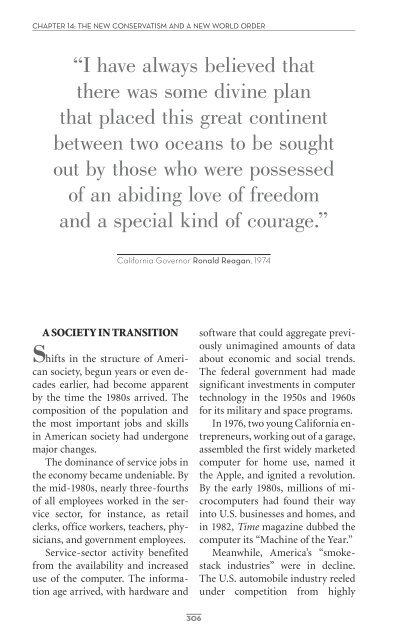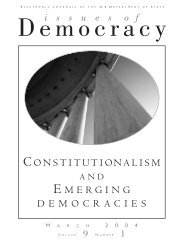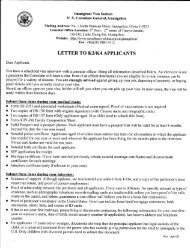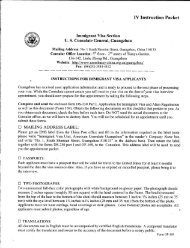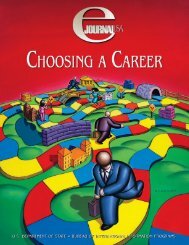s. history us history us history - Embassy of the United States
s. history us history us history - Embassy of the United States
s. history us history us history - Embassy of the United States
- No tags were found...
Create successful ePaper yourself
Turn your PDF publications into a flip-book with our unique Google optimized e-Paper software.
CHAPTER 14: THE NEW CONSERVATISM AND A NEW WORLD ORDEROUTLINE OF U.S. HISTORY“I have always believed that<strong>the</strong>re was some divine planthat placed this great continentbetween two oceans to be soughtout by those who were possessed<strong>of</strong> an abiding love <strong>of</strong> freedomand a special kind <strong>of</strong> courage.”A SOCIETY IN TRANSITIONShifts in <strong>the</strong> structure <strong>of</strong> Americansociety, begun years or even decadesearlier, had become apparentby <strong>the</strong> time <strong>the</strong> 1980s arrived. Thecomposition <strong>of</strong> <strong>the</strong> population and<strong>the</strong> most important jobs and skillsin American society had undergonemajor changes.The dominance <strong>of</strong> service jobs in<strong>the</strong> economy became undeniable. By<strong>the</strong> mid-1980s, nearly three-fourths<strong>of</strong> all employees worked in <strong>the</strong> servicesector, for instance, as retailclerks, <strong>of</strong>fice workers, teachers, physicians,and government employees.Service-sector activity benefitedfrom <strong>the</strong> availability and increased<strong>us</strong>e <strong>of</strong> <strong>the</strong> computer. The informationage arrived, with hardware andCalifornia Governor Ronald Reagan, 1974s<strong>of</strong>tware that could aggregate previo<strong>us</strong>lyunimagined amounts <strong>of</strong> dataabout economic and social trends.The federal government had madesignificant investments in computertechnology in <strong>the</strong> 1950s and 1960sfor its military and space programs.In 1976, two young California entrepreneurs,working out <strong>of</strong> a garage,assembled <strong>the</strong> first widely marketedcomputer for home <strong>us</strong>e, named it<strong>the</strong> Apple, and ignited a revolution.By <strong>the</strong> early 1980s, millions <strong>of</strong> microcomputershad found <strong>the</strong>ir wayinto U.S. b<strong>us</strong>inesses and homes, andin 1982, Time magazine dubbed <strong>the</strong>computer its “Machine <strong>of</strong> <strong>the</strong> Year.”Meanwhile, America’s “smokestackind<strong>us</strong>tries” were in decline.The U.S. automobile ind<strong>us</strong>try reeledunder competition from highlyefficient Japanese carmakers. By1980 Japanese companies alreadymanufactured a fifth <strong>of</strong> <strong>the</strong> vehiclessold in <strong>the</strong> <strong>United</strong> <strong>States</strong>. Americanmanufacturers struggled with somesuccess to match <strong>the</strong> cost efficienciesand engineering standards <strong>of</strong><strong>the</strong>ir Japanese rivals, but <strong>the</strong>ir formerdominance <strong>of</strong> <strong>the</strong> domestic carmarket was gone forever. The giantold-line steel companies shrank torelative insignificance as foreignsteel makers adopted new technologiesmore readily.Consumers were <strong>the</strong> beneficiaries<strong>of</strong> this ferocio<strong>us</strong> competition in <strong>the</strong>manufacturing ind<strong>us</strong>tries, but <strong>the</strong>painful struggle to cut costs meant<strong>the</strong> permanent loss <strong>of</strong> hundreds <strong>of</strong>tho<strong>us</strong>ands <strong>of</strong> blue-collar jobs. Thosewho could made <strong>the</strong> switch to <strong>the</strong>service sector; o<strong>the</strong>rs became unfortunatestatistics.Population patterns shifted aswell. After <strong>the</strong> end <strong>of</strong> <strong>the</strong> postwar“baby boom” (1946 to 1964), <strong>the</strong>overall rate <strong>of</strong> population growthdeclined and <strong>the</strong> population grewolder. Ho<strong>us</strong>ehold composition alsochanged. In 1980 <strong>the</strong> percentage<strong>of</strong> family ho<strong>us</strong>eholds dropped; aquarter <strong>of</strong> all groups were now classifiedas “nonfamily ho<strong>us</strong>eholds,”in which two or more unrelatedpersons lived toge<strong>the</strong>r.New immigrants changed <strong>the</strong>character <strong>of</strong> American society ino<strong>the</strong>r ways. The 1965 reform in immigrationpolicy shifted <strong>the</strong> foc<strong>us</strong>away from Western Europe, facilitatinga dramatic increase in new arrivalsfrom Asia and Latin America. In1980, 808,000 immigrants arrived,<strong>the</strong> highest number in 60 years, as <strong>the</strong>country once more became a havenfor people from around <strong>the</strong> world.Additional groups became activeparticipants in <strong>the</strong> struggle for equalopportunity. Homosexuals, <strong>us</strong>ing<strong>the</strong> tactics and rhetoric <strong>of</strong> <strong>the</strong> civilrights movement, depicted <strong>the</strong>mselvesas an oppressed group seekingrecognition <strong>of</strong> basic rights. In 1975,<strong>the</strong> U.S. Civil Service Commissionlifted its ban on employment <strong>of</strong>homosexuals. Many states enactedanti-discrimination laws.Then, in 1981, came <strong>the</strong> discovery<strong>of</strong> AIDS (Acquired ImmuneDeficiency Syndrome). Transmittedsexually or through blood transf<strong>us</strong>ions,it struck homosexual men andintraveno<strong>us</strong> drug <strong>us</strong>ers with particularvirulence, although <strong>the</strong> generalpopulation proved vulnerable aswell. By 1992, over 220,000 Americanshad died <strong>of</strong> AIDS. The AIDS epidemichas by no means been limitedto <strong>the</strong> <strong>United</strong> <strong>States</strong>, and <strong>the</strong> effort totreat <strong>the</strong> disease now encompassesphysicians and medical researchersthroughout <strong>the</strong> world.CONSERVATISM AND THERISE OF RONALD REAGANFor many Americans, <strong>the</strong> economic,social, and political trends <strong>of</strong> <strong>the</strong>previo<strong>us</strong> two decades — crime andracial polarization in many urbancenters, challenges to traditionalvalues, <strong>the</strong> economic downturn andinflation <strong>of</strong> <strong>the</strong> Carter years — engendereda mood <strong>of</strong> disill<strong>us</strong>ionment.306307


